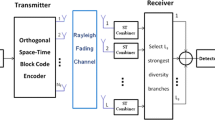Abstract
In this paper, a new MIMO scheme termed as precoded Spatially Modulated Non-orthogonal Space Time Block Code (precoded SM-NSTBC) is proposed. The primary concept of precoded SM-NSTBC is to activate a subset of receive antennas in a pre-defined manner and choose specific activated patterns to represent information symbols. We have synthesized schemes derived from full rank Cyclic codes defined over Galois field Rank preserving transformations are used to map the full rank codewords over a finite field to full rank Space Time Block Codes. Due to the characteristics of full rank Cyclic codes employed, a performance improvement of approximately 2 dB to 7 dB is observed. This advantage is realized when the performance of these schemes is compared with precoded SM-OSTBC and precoded STBC-SM. The improvement due to the coding gain is observed in both uncorrelated as well as correlated Rayleigh fading environments. An upper bound on the average bit error rate (ABER) is derived. Close correspondence between Monte-Carlo simulations and analytic values are observed.








Similar content being viewed by others
References
Foschini, G. J., & Gans, M. J. (1998). On limits of wireless communications in a fading environment when using multiple antennas. Wireless personal communications, Springer, 6(3), 311–335.
Foschini, G. J. (1996). Layered space-time architecture for wireless communication in a fading environment when using multi-element antennas. Bell labs technical journal, 1(2), 41–59.
Mesleh, R., Hiari, O., Younis, A., & Alouneh, S. (2017). Transmitter design and hardware considerations for different space modulation techniques. IEEE Transactions on Wireless Communications, 16(11), 7512–7522.
Alamouti, S. M. (1998). A simple transmit diversity technique for wireless communications. IEEE Journal on selected areas in communications, 16(8), 1451–1458.
Tarokh, V., Seshadri, N., & Calderbank, A. R. (1998). Space-time codes for high data rate wireless communication: Performance criterion and code construction. IEEE transactions on information theory, 44(2), 744–765.
Su, W., & Xia, X.-G. (2003). On space-time block codes from complex orthogonal designs. Wireless Personal Communications, Springer, 25(1), 1–26.
Basar, E., & Aygolu, U. (2009). High rate full-diversity space time block codes for three and four transmit antennas. IET communications, 3(8), 1371–1378.
Sripati, U., Rajan, B. S., Shashidhar, V. Full-diversity STBCs for blockfading channels from cyclic codes, Global Telecommunications Conference, 2004. GLOBECOM’04. IEEE 1 (2004) 566-570.
Mesleh, R., Haas, H., Sinanovic, S., Ahn, C. W., & Yun, S. (2008). Spatial Modulation. IEEE Transactions on Vehicular Technology, 57(4), 2228.
Younis, A. Spatial modulation: Theory to practice, The University of Edinburgh.
Simha, G. D. G., Koila, S., Neha, N., Raghavendra, M., & Sripati, U. (2017). Redesigned spatial modulation for spatially correlated fading channels. Wireless Personal Communications, Springer, 97(4), 500–5030.
Basar, E., Aygolu, U., Panayirci, E., & Poor, H. V. (2011). Space-time block coded spatial modulation. IEEE transactions on communications, 59(3), 823–832.
Le, M.-T., Ngo, V. D., Mai, H. A., Tran, X. N., & Di Renzo, M. (2013). Spatially modulated orthogonal space-time block codes with non-vanishing determinants. IEEE Transactions on Communications, 62(1), 85–99.
Wang, L., & Chen, Z. (2014). Correction to Spatially modulated orthogonal space-time block codes with non-vanishing determinants. IEEE Transactions on Communications, 62(10), 3723–3724.
Yang, L.-L. Transmitter preprocessing aided spatial modulation for multiple-input multiple-output systems, 2011 IEEE 73rd Vehicular Technology Conference (VTC Spring) (2011) 1-5.
Stavridis, A., Sinanovic, S., Di Renzo, M., Haas, H. Transmit precoding for receive spatial modulation using imperfect channel knowledge, 2012 IEEE 75th Vehicular Technology Conference (VTC Spring) (2012) 1-5.
Zhang, R., Yang, L.-L., & Hanzo, L. (2013). Generalised pre-coding aided spatial modulation. IEEE Transactions on Wireless Communications, 12(11), 5434–5443.
Li, J., Wen, M., Cheng, X., Yan, Y., Song, S., & Lee, M. H. (2016). Generalized precoding-aided quadrature spatial modulation. IEEE Transactions on Vehicular Technology, 66(2), 1881–1886.
Junshan, L., Wang, S., Wang, F., & Zhang W. (2018). Generalized Precoding-aided Spatial Modulation via Receive Antenna Transition. IEEE Wireless Communications Letters
Dong, R., Wang, F., Luo, J., Wang, D. Quadrature joint transmitter-receiver spatial modulation, 2019 11th International Conference on Wireless Communications and Signal Processing (WCSP), Xi’an, China, 2019, pp. 1-6, https://doi.org/10.1109/WCSP.2019.8928009.
Luo, J., Wang, S., & Wang, F. (2019). Joint transmitter-receiver spatial modulation design via minimum Euclidean distance maximization. IEEE Journal on Selected Areas in Communications, 37(9), 1986–2000.
Zhang, L., Sun, M., Ou, Z., Ouyang, C., & Yang, H. (2019). A secure receive spatial modulation scheme based on random precoding. IEEE Access, 7, 122367–122377.
Raafat, A., Agustin, A., & Vidal, J. (2020). Downlink multi-user massive MIMO transmission using receive spatial modulation. IEEE Transactions on Wireless Communications, 19(10), 6871–6883.
Godkhindi, S., Goutham Simha, G., & Acharya, U. S. Spatially modulated non orthogonal space time block code: Construction and design from Cyclic codes over Galois Field, Physical Communication, Elsevier (2019) 100735.
Moon, T. K. Error correction coding, Mathematical Methods and Algorithms. John Wiley and Son.
Lusina, P., Gabidulin, E., & Bossert, M. (2003). Maximum rank distance codes as space-time codes. IEEE Transactions on Information Theory, 49(10), 2757–2760.
Huber, K. (1994). Codes over Eisenstein-Jacobi integers. Contemporary Mathematics, 168, 165.
Huber, K. (1994). Codes over Gaussian Integers. IEEE Transactions on Information Theory, 40(1), 207–216.
Goutham Simha, G. D., Raghavendra, M., Shriharsha, K., & Acharya, U. S. (2017). Signal constellations employing multiplicative groups of Gaussian and Eisenstein integers for enhanced spatial modulation. Physical Communication, 25, 546–554.
Simon Marvin K., & Alouini, Mohamed-Slim (2005). Digital communication over fading channels. Vol. 95. John Wiley & Sons
Author information
Authors and Affiliations
Ethics declarations
Conflict of interest
On behalf of all authors, the corresponding author states that there is no conflict of interest.
Additional information
Publisher's Note
Springer Nature remains neutral with regard to jurisdictional claims in published maps and institutional affiliations.
Rights and permissions
About this article
Cite this article
Shashikant, S.G., Simha, G.D.G. & Acharya, U.S. Generalized designs for precoded receive spatial modulation derived from non-orthogonal space time block codes. Telecommun Syst 79, 405–416 (2022). https://doi.org/10.1007/s11235-021-00860-4
Accepted:
Published:
Issue Date:
DOI: https://doi.org/10.1007/s11235-021-00860-4




